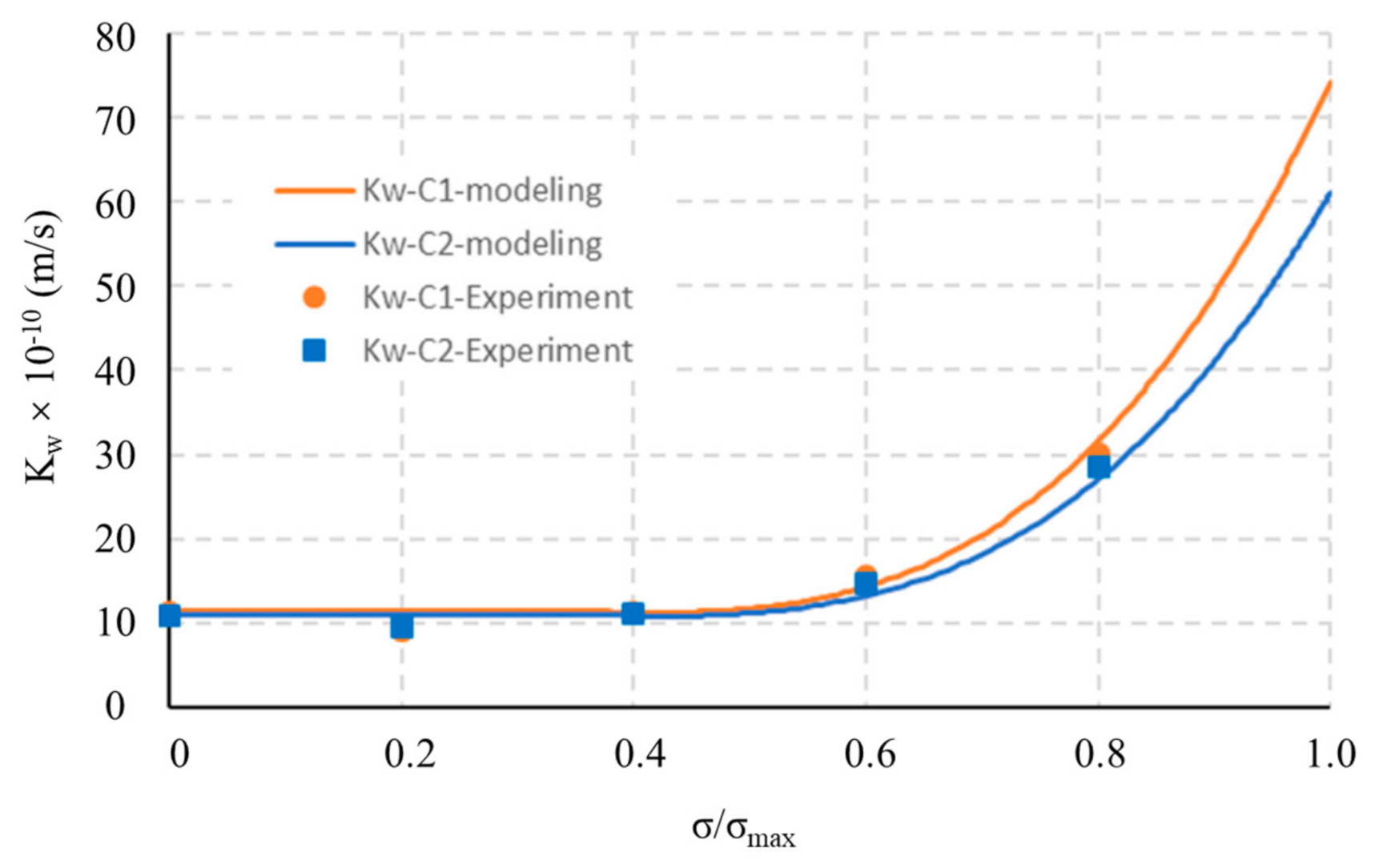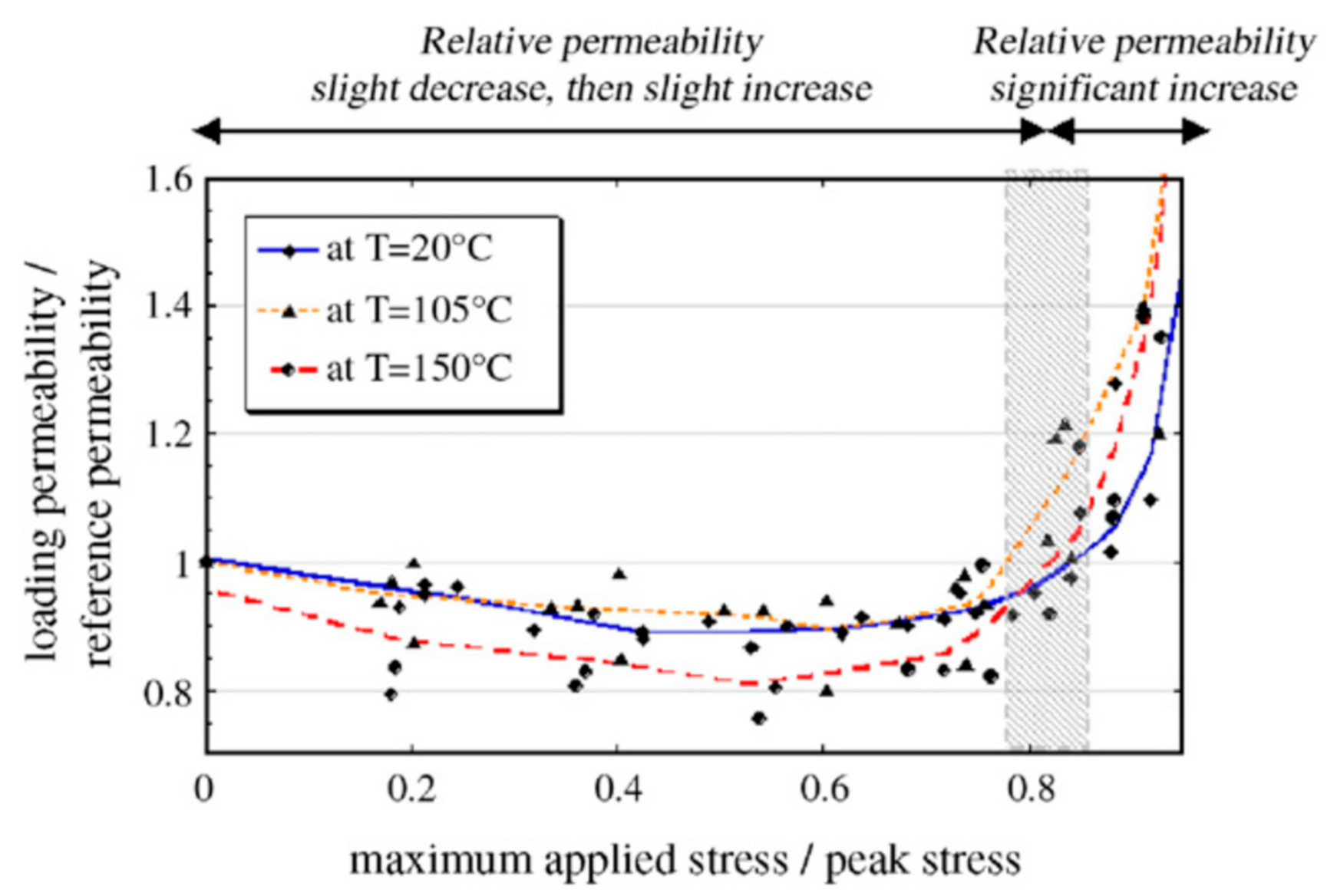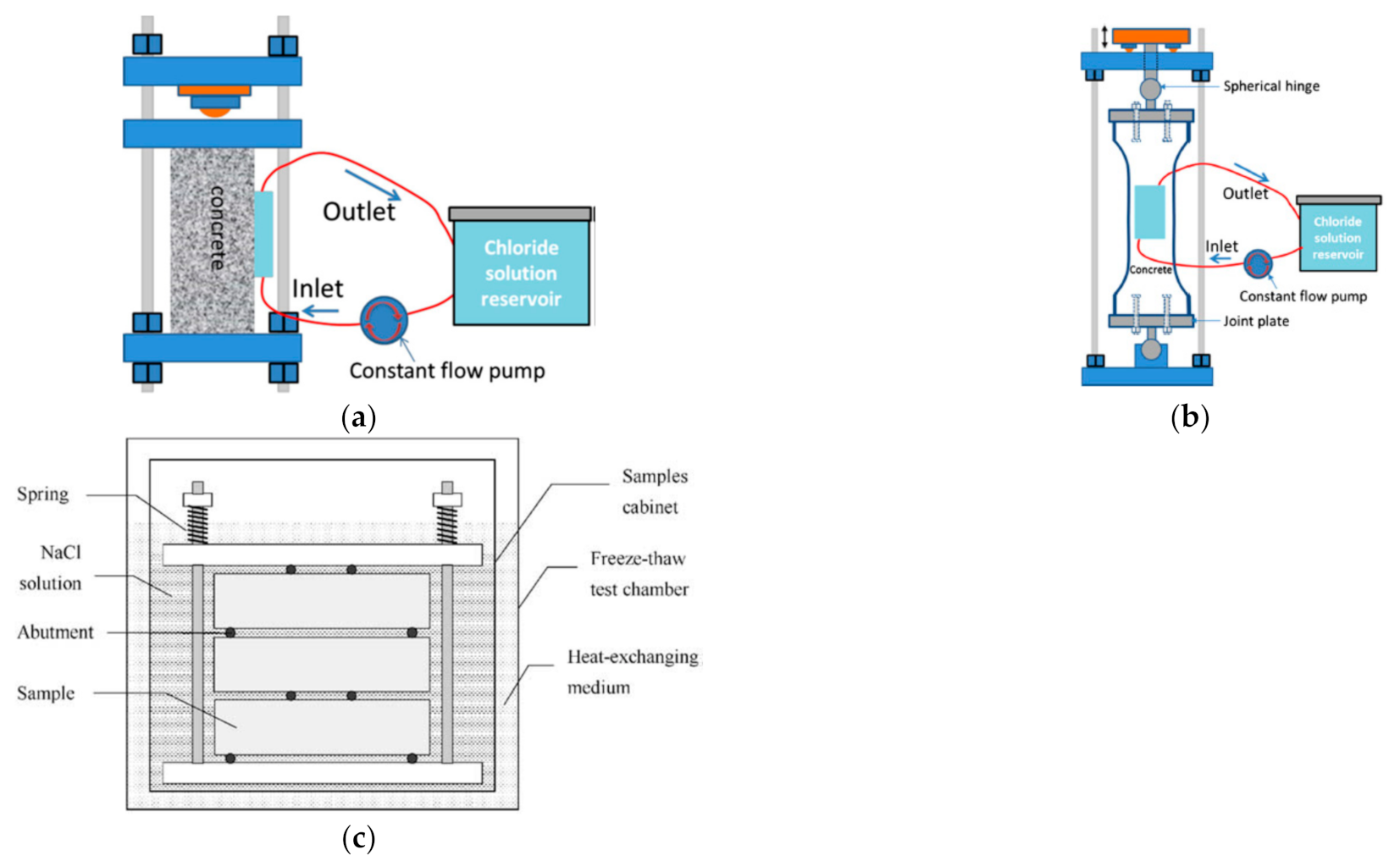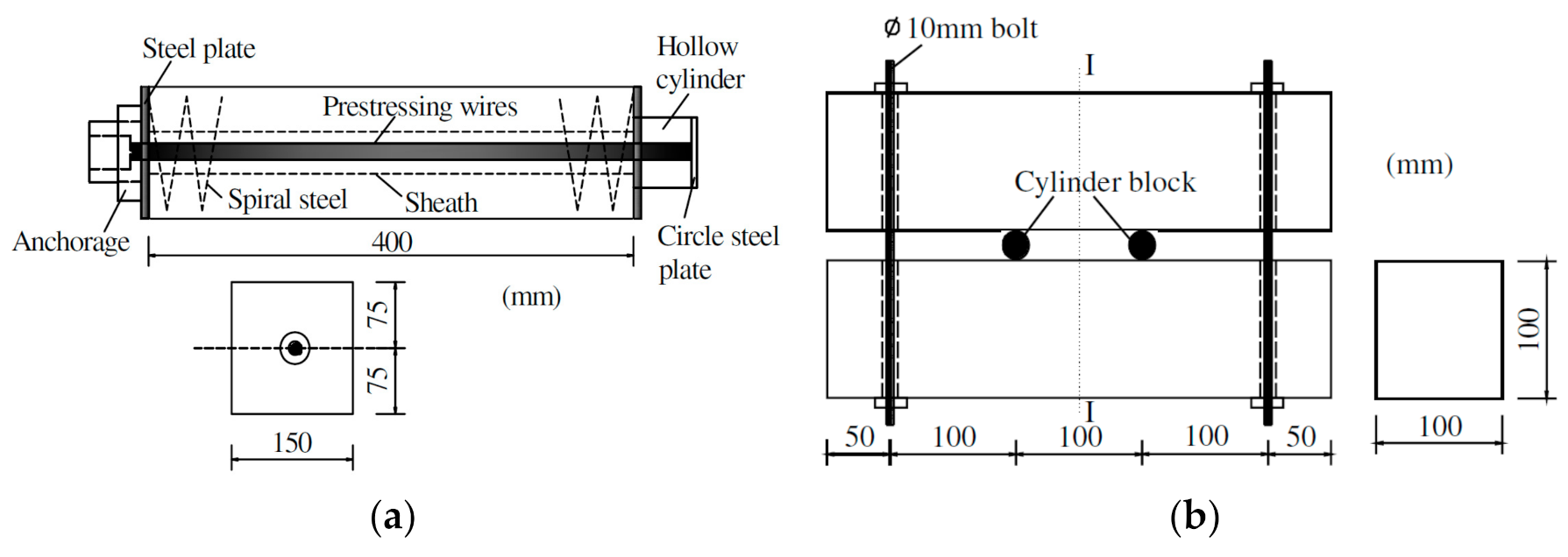Effect of the Mechanical Load on the Carbonation of Concrete: A Review of the Underlying Mechanisms, Test Methods, and Results
Abstract
:1. Introduction
2. Carbonation in Cracked and Load-Damaged Concrete
2.1. Effect of Crack Pattern on Concrete Carbonation
2.2. Effect of Load-Induced Damage on Concrete Carbonation
2.2.1. Static Load
2.2.2. Fatigue Load
3. Carbonation of Concrete under Sustained Load
3.1. Compressive and Tensile Load

3.2. Flexural Load
4. Test Methods for Carbonation of Concrete under Sustained Load
4.1. Specimen Size and Loading Devices
4.2. Load Application and Compensation
5. Conclusions
Author Contributions
Funding
Institutional Review Board Statement
Informed Consent Statement
Data Availability Statement
Acknowledgments
Conflicts of Interest
References
- García-González, C.A.; Hidalgo, A.; Andrade, C.; Alonso, M.C.; Fraile, J.; Lopez-Periago, A.M.; Domingo, C. Modification of composition and microstructure of portland cement pastes as a result of natural and supercritical carbonation procedures. Ind. Eng. Chem. Res. 2006, 45, 4985–4992. [Google Scholar] [CrossRef]
- Morandeau, A.E.; White, C.E. In situ X-ray pair distribution function analysis of accelerated carbonation of a synthetic calcium–silicate–hydrate gel. J. Mater. Chem. A 2015, 3, 8597–8605. [Google Scholar] [CrossRef]
- Morandeau, A.; Thiéry, M.; Dangla, P. Investigation of the carbonation mechanism of CH and C-S-H in terms of kinetics, microstructure changes and moisture properties. Cem. Concr. Res. 2014, 56, 153–170. [Google Scholar] [CrossRef] [Green Version]
- Black, L.; Breen, C.; Yarwood, J.; Garbev, K.; Stemmermann, P.; Gasharova, B. Structural features of C?S?H(I) and its carbonation in air?A raman spectroscopic study. Part II: Carbonated phases. J. Am. Ceram. Soc. 2007, 90, 908–917. [Google Scholar] [CrossRef]
- Fernández-Carrasco, L.; Torrens-Martin, D.; Martinez-Ramirez, S. Carbonation of ternary building cementing materials. Cem. Concr. Compos. 2012, 34, 1180–1186. [Google Scholar] [CrossRef]
- Xiantuo, C.; Ruizhen, Z.; Xiaorong, C. Kinetic study of ettringite carbonation reaction. Cem. Concr. Res. 1994, 24, 1383–1389. [Google Scholar] [CrossRef]
- De Han, J.; Pan, G.; Sun, W.; Wang, C.; Cui, D. Application of nanoindentation to investigate chemomechanical properties change of cement paste in the carbonation reaction. Sci. China Technol. Sci. 2011, 55, 616–622. [Google Scholar] [CrossRef]
- Peter, M.; Muntean, A.; Meier, S.; Böhm, M. Competition of several carbonation reactions in concrete: A parametric study. Cem. Concr. Res. 2008, 38, 1385–1393. [Google Scholar] [CrossRef] [Green Version]
- Šavija, B.; Luković, M. Carbonation of cement paste: Understanding, challenges, and opportunities. Constr. Build. Mater. 2016, 117, 285–301. [Google Scholar] [CrossRef] [Green Version]
- Ekolu, S.O. A review on effects of curing, sheltering, and CO2 concentration upon natural carbonation of concrete. Constr. Build. Mater. 2016, 127, 306–320. [Google Scholar] [CrossRef]
- Chang, C.-F.; Chen, J.-W. The experimental investigation of concrete carbonation depth. Cem. Concr. Res. 2006, 36, 1760–1767. [Google Scholar] [CrossRef]
- Marques, P.F.; Chastre, C.; Nunes, Â. Carbonation service life modelling of RC structures for concrete with Portland and blended cements. Cem. Concr. Compos. 2013, 37, 171–184. [Google Scholar] [CrossRef]
- Salvoldi, B.G.; Beushausen, H.; Alexander, M.G. Oxygen permeability of concrete and its relation to carbonation. Constr. Build. Mater. 2015, 85, 30–37. [Google Scholar] [CrossRef]
- Houst, Y.F.; Wittmann, F.H. Influence of porosity and water content on the diffusivity of CO2 and O2 through hydrated cement paste. Cem. Concr. Res. 1994, 24, 1165–1176. [Google Scholar] [CrossRef]
- Sanjuán, M.A.; Andrade, C.; Cheyrezy, M. Concrete carbonation tests in natural and accelerated conditions. Adv. Cem. Res. 2003, 15, 171–180. [Google Scholar] [CrossRef]
- Eurocode 2. Design of Concrete Structures; British Standards Institution: London, UK, 2008. [Google Scholar]
- François, R.; Maso, J. Effect of damage in reinforced concrete on carbonation or chloride penetration. Cem. Concr. Res. 1988, 18, 961–970. [Google Scholar] [CrossRef]
- Liang, M.-T.; Qu, W.-J.; Liao, Y.-S. A study on carbonation in concrete structures at existing cracks. J. Chin. Inst. Eng. 2000, 23, 143–153. [Google Scholar] [CrossRef]
- Song, H.-W.; Kwon, S.-J.; Byun, K.-J.; Park, C.-K. Predicting carbonation in early-aged cracked concrete. Cem. Concr. Res. 2006, 36, 979–989. [Google Scholar] [CrossRef]
- Arandigoyen, M.; Bicer-Simsir, B.; Alvarez, J.; Lange, D. Variation of microstructure with carbonation in lime and blended pastes. Appl. Surf. Sci. 2006, 252, 7562–7571. [Google Scholar] [CrossRef] [Green Version]
- Hiep Dang, V.; François, R.; L’Hostis, V. Effects of pre-cracks on both initiation and propagation of re-bar corrosion in pure carbon dioxide. EPJ Web Conf. 2013, 56, 6006. [Google Scholar] [CrossRef] [Green Version]
- Van Tittelboom, K.; de Belie, N. Self-healing in cementitious materials—A review. Materials 2013, 6, 2182–2217. [Google Scholar] [CrossRef] [Green Version]
- Zhang, S.P.; Zong, L.; Dong, L.F.; Zhang, W. Influence of cracking on carbonation of cement-based materials. Adv. Mater. Res. 2011, 261-263, 84–88. [Google Scholar] [CrossRef]
- De Schutter, G. Quantification of the influence of cracks in concrete structures on carbonation and chloride penetration. Mag. Concr. Res. 1999, 51, 427–435. [Google Scholar] [CrossRef]
- Van Mullem, T.; de Meyst, L.; Handoyo, J.P.; Caspeele, R.; de Belie, N.; Heede, P.V.D. Influence of crack geometry and crack width on carbonation of High-Volume Fly Ash (HVFA) mortar. In Proceedings of the International RILEM Conference on Ambitioning a Sustainable Future for Built Environment: Comprehensive Strategies for Unprecedented Challenges, Guimarães, Portugal, 10–14 March 2020. [Google Scholar]
- Alahmad, S.; Toumi, A.; Verdier, J.; Francois, R. Effect of crack opening on carbon dioxide penetration in cracked mortar samples. Mater. Struct. 2008, 42, 559–566. [Google Scholar] [CrossRef]
- Bogas, J.; Carriço, A.; Pontes, J. Influence of cracking on the capillary absorption and carbonation of structural lightweight aggregate concrete. Cem. Concr. Compos. 2019, 104. [Google Scholar] [CrossRef]
- Al-Ameeri, A.; Rafiq, M.I.; Tsioulou, O. Influence of cracks on the carbonation resistance of concrete structures. In Proceedings of the 6th International Conference on Durability of Concrete Structures (ICDCS 2018), Leeds, UK, 18–20 July 2020; pp. 1–8. [Google Scholar]
- Torres, J.; Andrade, C. Influence of crack width on long term degradation of concrete Structures. In Durability of Reinforced Concrete from Composition to Protection; Springer: Cham, Switzerland, 2015; pp. 87–98. [Google Scholar] [CrossRef]
- Carević, V.; Ignjatović, I. Influence of loading cracks on the carbonation resistance of RC elements. Constr. Build. Mater. 2019, 227, 116583. [Google Scholar] [CrossRef]
- Fabien, A.; Choinska, M.; Bonnet, S.; Khelidj, A. Experimental study of aggregates size effect on strain, damage and permeability of concrete. Key Eng. Mater. 2017, 729, 115–121. [Google Scholar] [CrossRef]
- Zhou, C.; Li, K.; Pang, X. Geometry of crack network and its impact on transport properties of concrete. Cem. Concr. Res. 2012, 42, 1261–1272. [Google Scholar] [CrossRef]
- Sugiyama, T.; Bremner, T.W.; Holm, T.A. Effect of stress on gas permeability in concrete. ACI Mater. J. 1996, 93. [Google Scholar] [CrossRef]
- Picandet, V.; Khelidj, A.; Bellegou, H. Crack effects on gas and water permeability of concretes. Cem. Concr. Res. 2009, 39, 537–547. [Google Scholar] [CrossRef] [Green Version]
- Picandet, V.; Khelidj, A.; Bastian, G. Effect of axial compressive damage on gas permeability of ordinary and high-performance concrete. Cem. Concr. Res. 2001, 31, 1525–1532. [Google Scholar] [CrossRef] [Green Version]
- Zhang, D.; Yang, Q.; Mao, M.; Li, J. Carbonation performance of concrete with fly ash as fine aggregate after stress damage and high temperature exposure. Constr. Build. Mater. 2020, 242, 118125. [Google Scholar] [CrossRef]
- Wan, X.; Zhao, T.; Jiang, F.; Su, Q. Experimental research on carbonation performance of mechanical loaded concrete. In Proceedings of the Fifth Syposium Strait Crossings, Trondheim, Norway, 21–24 June 2009; p. 525. [Google Scholar]
- Wang, X.-H.; Val, D.V.; Zheng, L.; Jones, M.R. Influence of loading and cracks on carbonation of RC elements made of different concrete types. Constr. Build. Mater. 2018, 164, 12–28. [Google Scholar] [CrossRef] [Green Version]
- Wang, X.-H.; Val, D.V.; Zheng, L.; Jones, R. Carbonation of loaded RC elements made of different concrete types: Accelerated testing and future predictions. Constr. Build. Mater. 2020, 243, 118259. [Google Scholar] [CrossRef]
- Choinska, M.; Khelidj, A.; Chatzigeorgiou, G.; Pijaudier-Cabot, G. Effects and interactions of temperature and stress-level related damage on permeability of concrete. Cem. Concr. Res. 2007, 37, 79–88. [Google Scholar] [CrossRef] [Green Version]
- Lee, M.; Barr, B. An overview of the fatigue behaviour of plain and fibre reinforced concrete. Cem. Concr. Compos. 2004, 26, 299–305. [Google Scholar] [CrossRef]
- Song, L.; Liu, J.-L.; Cui, C.-X.; Yu, Z.-W.; Fan, Z.-W.; Hou, J. Carbonation process of reinforced concrete beams under the combined effects of fatigue damage and environmental factors. Appl. Sci. 2020, 10, 3981. [Google Scholar] [CrossRef]
- Jiang, C.; Huang, Q.; Gu, X.; Zhang, W. Experimental investigation on carbonation in fatigue-damaged concrete. Cem. Concr. Res. 2017, 99, 38–52. [Google Scholar] [CrossRef]
- Dai, J.; Guo, L.; Liu, Y.; Zhu, K. Experimental study of the damage on concrete subjected to combined act ion of fatigue loading and carbonation. Concrete 2017, 63–66, 70. (In Chinese) [Google Scholar] [CrossRef]
- Wang, K.; Jansen, D.C.; Shah, S.P.; Karr, A.F. Permeability study of cracked concrete. Cem. Concr. Res. 1997, 27, 381–393. [Google Scholar] [CrossRef] [Green Version]
- Wang, Y.; Jiang, X.; Wang, S.; Yang, W.; Liu, W.; Xing, F.; Yang, K.; Basheer, P. Influence of axial loads on CO2 and Cl− transport in concrete phases: Paste, mortar and ITZ. Constr. Build. Mater. 2019, 204, 875–883. [Google Scholar] [CrossRef] [Green Version]
- Min, W. Carbonization and Chlorine Ion Erosion Test and Theoretical Analysis of Steamed Prestressed Concrete; Central South University: Changsha, China, 2012; (In Chinese). [Google Scholar] [CrossRef]
- Tian, H.; Li, G.; Liu, J.; Wu, Y. Experimental research on carbonation of forced concrete specimens. J. Tongji Univ. Nat. Sci. 2008, 38, 200–204. (In Chinese) [Google Scholar] [CrossRef]
- Luo, X.; Zou, H.; Shi, Q. Experimental study on durability of concrete carbonation at different stress states. J. Nat. Disasters 2012, 21, 194–199. (In Chinese) [Google Scholar] [CrossRef]
- Tang, J.; Wu, J.; Zou, Z.; Yue, A.; Mueller, A. Influence of axial loading and carbonation age on the carbonation resistance of recycled aggregate concrete. Constr. Build. Mater. 2018, 173, 707–717. [Google Scholar] [CrossRef]
- Koh, T.-H.; Kim, M.-K.; Yang, K.-H.; Yoon, Y.-S.; Kwon, S.-J. Service life evaluation of RC T-girder under carbonation considering cold joint and loading effects. Constr. Build. Mater. 2019, 226, 106–116. [Google Scholar] [CrossRef]
- Wang, W.; Lu, C.; Li, Y.; Yuan, G.; Li, Q. Effects of stress and high temperature on the carbonation resistance of fly ash concrete. Constr. Build. Mater. 2017, 138, 486–495. [Google Scholar] [CrossRef]
- Liu, X. Study on Carbonization and Chlorine Ion Penetration Corrosion Regularity of Coastal Concrete Bridge under Load in Service; Qingdao Technological University: Qingdao, China, 2010; (In Chinese). [Google Scholar] [CrossRef]
- Han, J.; Liu, W.; Wang, S.; Geert, D.S.; Sun, W.; Liang, Y. Carbonation reaction and microstructural changes of metro-tunnel segment concrete coupled with static and fatigue load. J. Mater. Civ. Eng. 2017, 29, 04016216. [Google Scholar] [CrossRef]
- Liu, Y.; Ren, J.; Li, Z.; Gao, Q.; Zhao, S. Carbonization resistance of reinforced concrete under bending load. Frat. Integrita Strutt. 2019, 13, 714–724. [Google Scholar] [CrossRef]
- Zhang, P.; Wang, S.; Han, J.; Liu, W. Carbonation resistance and microstructure evolution of concrete under static load test. Concrete 2017, 45–51. (In Chinese) [Google Scholar] [CrossRef]
- Niu, J.; Niu, D.; Liu, W. Research on carbonation rule of fly ash concrete influenced by bending load. Bull. Chin. Ceram. Soc. 2011, 30, 140–146. (In Chinese) [Google Scholar] [CrossRef]
- Zheng, J.; Huang, L. Experimental study on carbonation of self-compacting concrete under tensile and compressive stresses. J. Build. Mater. 2013, 16, 115–120. (In Chinese) [Google Scholar] [CrossRef]
- Wan, X.; Wittmann, F.H.; Zhao, T. Influence of mechanical load on service life of reinforced concrete structures under dominant influence of carbonation. Restor. Build. Monum. 2011, 17, 103–110. [Google Scholar] [CrossRef]
- Lim, C.; Gowripalan, N.; Sirivivatnanon, V. Microcracking and chloride permeability of concrete under uniaxial compression. Cem. Concr. Compos. 2000, 22, 353–360. [Google Scholar] [CrossRef]
- Bhargava, A.; Banthia, N. Measurement of concrete permeability under stress. Exp. Tech. 2006, 30, 28–31. [Google Scholar] [CrossRef]
- Banthia, N.; Bhargava, A. Permeability of stressed concrete and role of fiber reinforcement. ACI Mater. J. 2007, 104, 70–76. [Google Scholar] [CrossRef]
- Banthia, N.; Biparva, A.; Mindess, S. Permeability of concrete under stress. Cem. Concr. Res. 2005, 35, 1651–1655. [Google Scholar] [CrossRef]
- Wimalasiri, M.; Robert, D.; Li, C.-Q. Permeability degradation of stressed concrete considering concrete plasticity. J. Mater. Civ. Eng. 2020, 32, 04020265. [Google Scholar] [CrossRef]
- Miah, J.; Kallel, H.; Carré, H.; Pimienta, P.; La Borderie, C. The effect of compressive loading on the residual gas permeability of concrete. Constr. Build. Mater. 2019, 217, 12–19. [Google Scholar] [CrossRef]
- Tang, G.; Yao, Y.; Wang, L.; Cui, S.; Cao, Y. Relation of Damage Variable and Gas Permeability Coefficient of Concrete under Stress. J. Wuhan Univ. Technol. Mater. Sci. Ed. 2018, 33, 1481–1485. [Google Scholar] [CrossRef]
- Xue, W.; Liu, X.; Jing, W.; Yao, Z.; Gao, C.; Li, H. Experimental study and mechanism analysis of permeability sensitivity of mechanically damaged concrete to confining pressure. Cem. Concr. Res. 2020, 134, 106073. [Google Scholar] [CrossRef]
- Lion, M.; Skoczylas, F.; Lafhaj, Z.; Sersar, M. Experimental study on a mortar. Temperature effects on porosity and permeability. Residual properties or direct measurements under temperature. Cem. Concr. Res. 2005, 35, 1937–1942. [Google Scholar] [CrossRef]
- Tran, T.; Pham, D.; Vu, M.; Truong, V.; Ho, X.; Tran, N.; Nguyen-Sy, T.; To, Q. Relation between water permeability and chloride diffusivity of concrete under compressive stress: Experimental investigation and mesoscale lattice modelling. Constr. Build. Mater. 2021, 267, 121164. [Google Scholar] [CrossRef]
- Van Vliet, M.R.A.; van Mier, J.G.M. Experimental investigation of concrete fracture under uniaxial compression. Mech. Cohesive-Frict. Mater. 1996, 1, 115–127. [Google Scholar] [CrossRef]
- Mi, R.; Liew, K.; Pan, G.; Kuang, T. Carbonation resistance study and inhomogeneity evolution of recycled aggregate concretes under loading effects. Cem. Concr. Compos. 2021, 118, 103916. [Google Scholar] [CrossRef]
- Castel, A.; Francois, R.; Arliguie, G. Effect of loading on carbonation penetration in reinforced concrete elements. Cem. Concr. Res. 1999, 29, 561–565. [Google Scholar] [CrossRef]
- Xiao, J.; Lei, B.; Zhang, C. On carbonation behavior of recycled aggregate concrete. Sci. China Technol. Sci. 2012, 55, 2609–2616. [Google Scholar] [CrossRef]
- Wang, J.; Ng, P.-L.; Su, H.; Chen, J.; Du, J. Effect of concrete stress states on carbonation depth of concrete. J. Civ. Eng. Manag. 2019, 25, 518–530. [Google Scholar] [CrossRef]
- Wang, J.; Su, H.; Du, J. Influence of coupled effects between flexural tensile stress and carbonation time on the carbonation depth of concrete. Constr. Build. Mater. 2018, 190, 439–451. [Google Scholar] [CrossRef]
- Mi, R.; Pan, G.; Shen, Q. Carbonation modelling for cement-based materials considering influences of aggregate and interfacial transition zone. Constr. Build. Mater. 2019, 229, 116925. [Google Scholar] [CrossRef]
- Mi, R.; Pan, G.; Liew, K. Predicting carbonation service life of reinforced concrete beams reflecting distribution of carbonation zones. Constr. Build. Mater. 2020, 255, 119367. [Google Scholar] [CrossRef]
- Chen, J.; Song, X.; Zhao, T.; Tian, L. Service life prediction of lining concrete of subsea tunnel under combined compressive load and carbonation. J. Wuhan Univ. Technol. Mater. Sci. Ed. 2010, 25, 1061–1064. [Google Scholar] [CrossRef]
- Jin, Z.Q.; Sun, W.; Zhang, Y.S.; Liu, Z.Y. Study on carbonation of concrete under loading. J. Build. Mater. 2005, 8, 179–183. (In Chinese) [Google Scholar] [CrossRef]
- Yao, Y.; Wang, L.; Wittmann, F.H.; de Belie, N.; Schlangen, E.; Gehlen, C.; Wang, Z.; Alava, H.E.; Cao, Y.; Yunus, B.M.; et al. Recommendation of RILEM TC 246-TDC: Test methods to determine durability of concrete under combined environmental actions and mechanical load. Mater. Struct. 2017, 50, 155. [Google Scholar] [CrossRef]
- Yao, Y.; Wang, L.; Wittmann, F.H.; de Belie, N.; Schlangen, E.; Eguez Alava, H.; Wang, Z.; Kessler, S.; Gehlen, C.; Yunus, B.M.; et al. Test methods to determine durability of concrete under combined environmental actions and mechanical load: Final report of RILEM TC 246-TDC. Mater. Struct. 2016, 50, 123. [Google Scholar] [CrossRef]
- Mu, R.; Miao, C.; Luo, X.; Sun, W. Interaction between loading, freeze–thaw cycles, and chloride salt attack of concrete with and without steel fiber reinforcement. Cem. Concr. Res. 2002, 32, 1061–1066. [Google Scholar] [CrossRef]
- de Yang, L.; Pan, H.K.; Zhu, Y.Z.; Wu, Z.Z. Experimental study of concrete’s carbonization resistance under combined action of factors. J. Build. Mater. 2008, 11, 345–348. (In Chinese) [Google Scholar] [CrossRef]
- Van Mullem, T. Development of Standard Testing Methods to Evaluate the Self-Healing Efficiency of Concrete; Ghent University: Ghent, Belgium, 2020; Available online: http://hdl.handle.net/1854/LU-8694912 (accessed on 22 February 2021).
- Lamparter, S.; Vogel, M.; Dehn, F. Innovative test method for the investigation of carbonation and chloride ingress on reinforced concrete components exposed to mechanical loads. In Life-Cycle Civil Engineering: Innovation, Theory and Practice; CRC Press: Boca Raton, FL, USA, 2021; pp. 188–194. [Google Scholar]
- Wang, H.; Lu, C.; Jin, W.; Bai, Y. Effect of external loads on chloride transport in concrete. J. Mater. Civ. Eng. 2011, 23, 1043–1049. [Google Scholar] [CrossRef]
- Zhang, Y.; Sun, W.; Chen, S.; Guo, F. Multi-dimensional carbonation and service life prediction model of fly ash concrete sub-jected to flexural stress and CO2 attack. J. Southeast Univ. Natural Sci. Ed. 2006, 36, 226–233. (In Chinese) [Google Scholar]





| Crack Type | Crack Inducing Method | CO2 Level | Crack Pattern | Lower/Upper Crack Width Threshold (μm) | Reference |
|---|---|---|---|---|---|
| Artificial crack | Embedding of thin plates | 20% | 100, 200, 300, 500, 620 μm in width and 20 mm in depth | −/100 | [23] |
| Artificial crack | Embedding of thin plates | 10% | 200, 300, 500 μm in width and 5, 10 mm in depth | * | [24] |
| Artificial crack | Embedding of thin plates | 1% | 100, 200, 300 μm in width and 30 mm in depth | −/100 | [25] |
| Realistic crack | Splitting | 1% | 100, 200, 300 μm in width | * | [25] |
| Artificial crack | Sawed and smoothed | 50% | 10–150 μm in width | * | [26] |
| Realistic crack | Expansive core | 50% | 9–400 μm in width | 9/60 | [26] |
| Artificial crack | Embedding of thin plates | 3% | 100, 200, 300 μm in width and 10 mm in depth | −/100 | [27] |
| Realistic crack | Bending | 3% | 100, 150 μm in width | * | [27] |
| Realistic crack | Bending | 5% | 50–350 μm in width | * | [28] |
| Realistic crack | Bending | Natural | 80, 500, 700 μm in width | * | [29] |
| Realistic crack | Bending | 2% | 50, 100, 150, 200, 300 μm in width | * | [30] |
| Specimen Size (mm3) | CO2 Level | Load Type | Load Level (Compression/ Tension) | Carbonation Depth Variation (under Compression/Tension) 1 | Compressive Load Level Threshold | Reference |
|---|---|---|---|---|---|---|
| 40 × 40 × 160 | 5% | Uniaxial compression and tension | 0.2, 0.4/0.2, 0.4, 0.6 | * | [46] | |
| 100 × 100 × 400 | 20% | Compression and bending tension | 0.2, 0.35, 0.5/0.3, 0.5, 0.7 | 0.61/1.38 | * | [47] |
| 100 × 100 × 400 | 20% | Compression and bending tension | 0.05, 0.3, 0.5/0.3, 0.5, 0.7 | 0.21/1.27 | * | [48] |
| 100 × 100 × 400 | 20% | Compression and bending tension | 0.15, 0.3, 0.45, 0.6, 0.75 | 0.534/1.30 | * | [49] |
| 100 × 100 × 50 | 20% | Uniaxial compression and tension | 0.2, 0.4, 0.6 | 0.91–1.45/1.39 | 0.2 | [50] |
| 100 × 100 × 40 for compression and φ100 × 40 for tension | 5% | Compression and splitting tension | 0.3, 0.6 | 0.88–1.26/1.44 | 0.3 | [51] |
| 100 × 100 × 300 for compression and 100 × 100 × 500 for bending | 20% | Compression and bending tension | 0.3, 0.5, 0.7, 0.9 | 0.3 | [52] | |
| 100 × 100 × 400 for compression and 100 × 170 × 440 for tension | 20% | Uniaxial compression and tension | 0.35, 0.65, 0.75/0.35, 0.65 | 0.35 | [53] | |
| 100 × 100 × 400 | 20% | 4-point bending | 0.3, 0.4, 0.5 | * | [54] | |
| 100 × 100 × 300 | 20% | 3-point bending | 0.2, 0.3, 0.4 | 0.61/1.51 | * | [55] |
| 100 × 100 × 400 | 20% | 4-point bending | 0.3, 0.4, 0.5 | * | [56] | |
| 100 × 100 × 550 | 20% | 4-point bending | 0.2, 0.4, 0.6 | 0.72/2.28 | * | [57] |
| 70.7 × 70.7 × 212 | 20% | 4-point bending | 0.2, 0.4, 0.6 | 0.89–1.26/1.66 | 0.2 | [58] |
| 100 × 100 × 400 | 20% | 4-point bending | 0.3, 0.5, 0.6, 0.8 | 0.89–1.51/1.64 | 0.3 | [59] |
Publisher’s Note: MDPI stays neutral with regard to jurisdictional claims in published maps and institutional affiliations. |
© 2021 by the authors. Licensee MDPI, Basel, Switzerland. This article is an open access article distributed under the terms and conditions of the Creative Commons Attribution (CC BY) license (https://creativecommons.org/licenses/by/4.0/).
Share and Cite
Liu, Z.; Van den Heede, P.; De Belie, N. Effect of the Mechanical Load on the Carbonation of Concrete: A Review of the Underlying Mechanisms, Test Methods, and Results. Materials 2021, 14, 4407. https://doi.org/10.3390/ma14164407
Liu Z, Van den Heede P, De Belie N. Effect of the Mechanical Load on the Carbonation of Concrete: A Review of the Underlying Mechanisms, Test Methods, and Results. Materials. 2021; 14(16):4407. https://doi.org/10.3390/ma14164407
Chicago/Turabian StyleLiu, Zhiyuan, Philip Van den Heede, and Nele De Belie. 2021. "Effect of the Mechanical Load on the Carbonation of Concrete: A Review of the Underlying Mechanisms, Test Methods, and Results" Materials 14, no. 16: 4407. https://doi.org/10.3390/ma14164407







